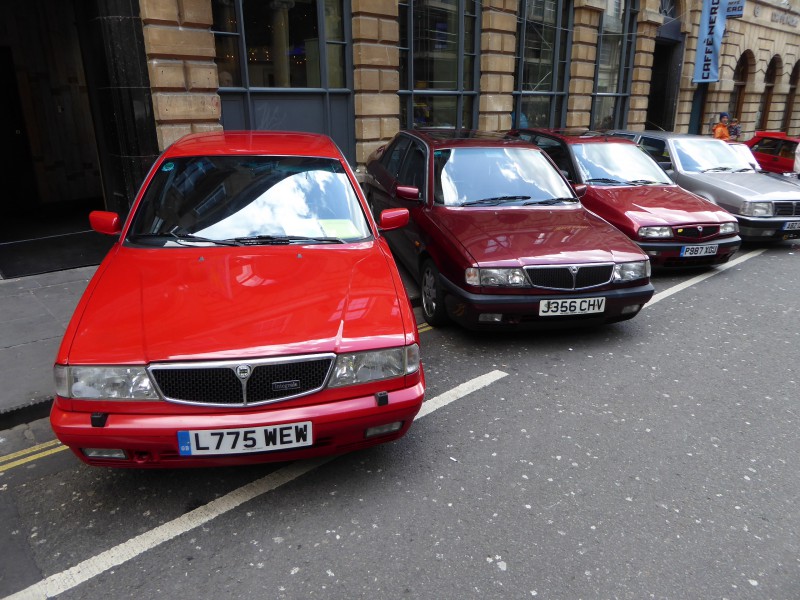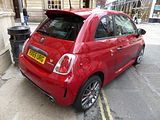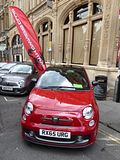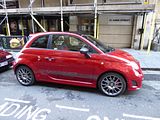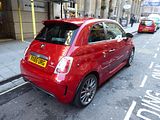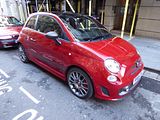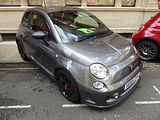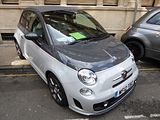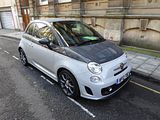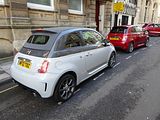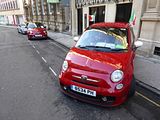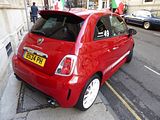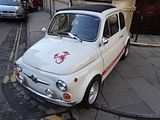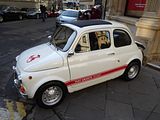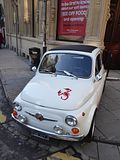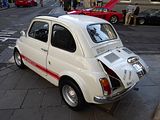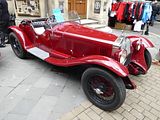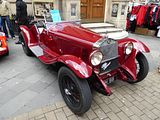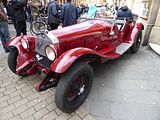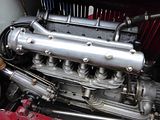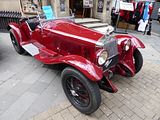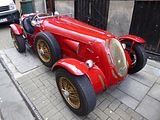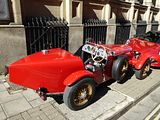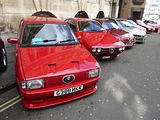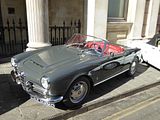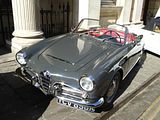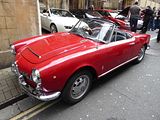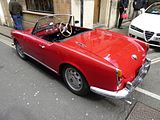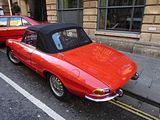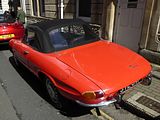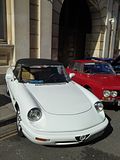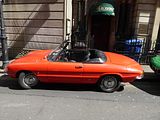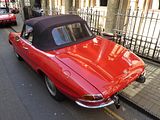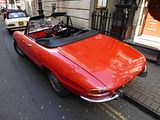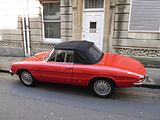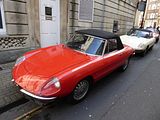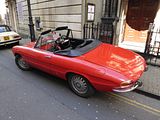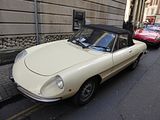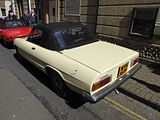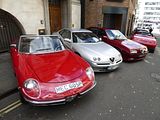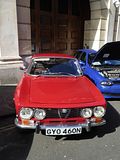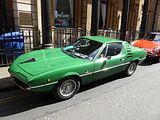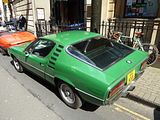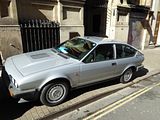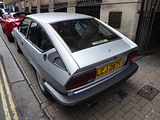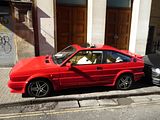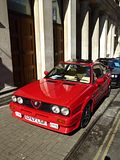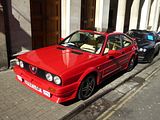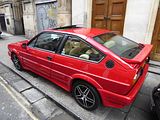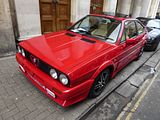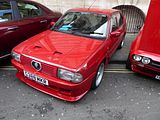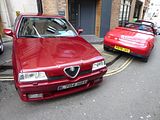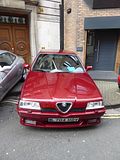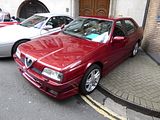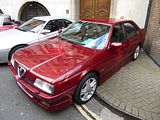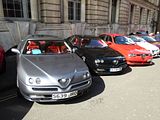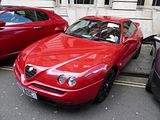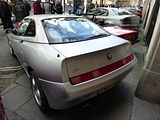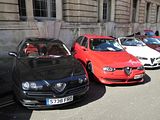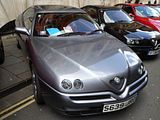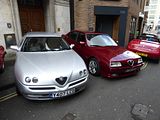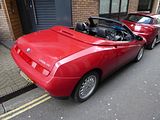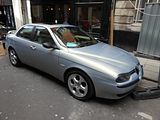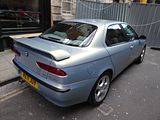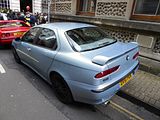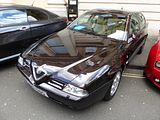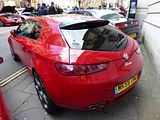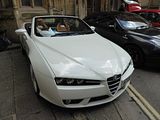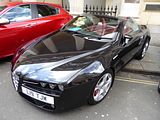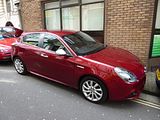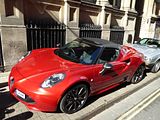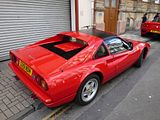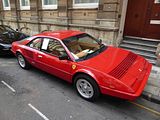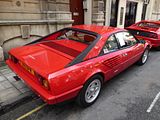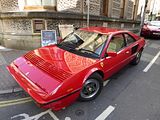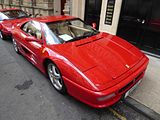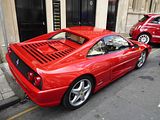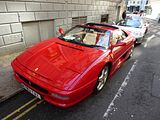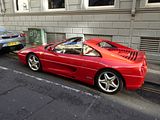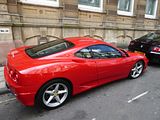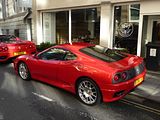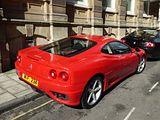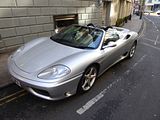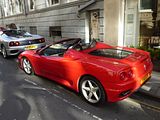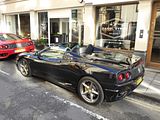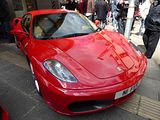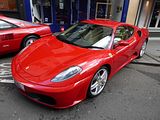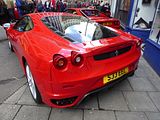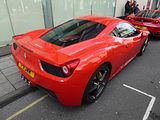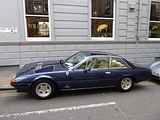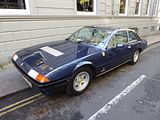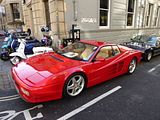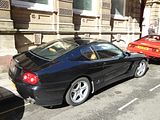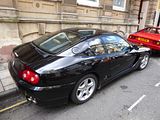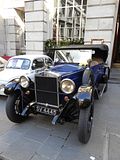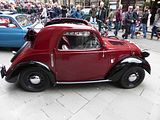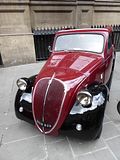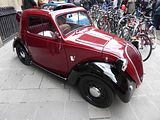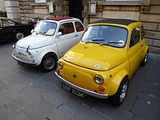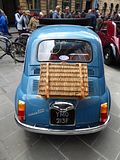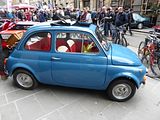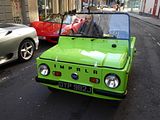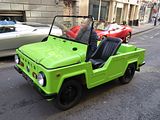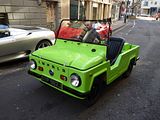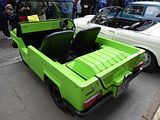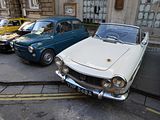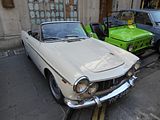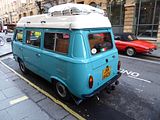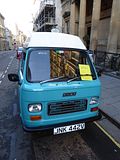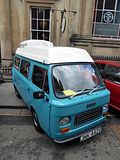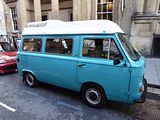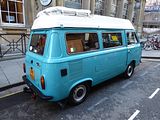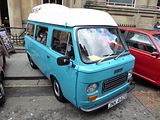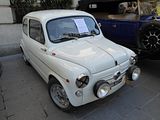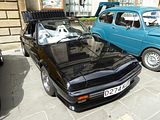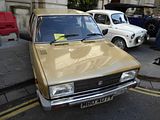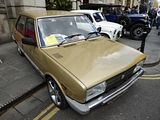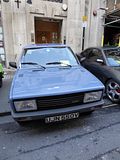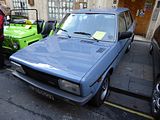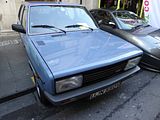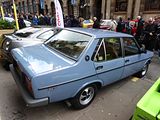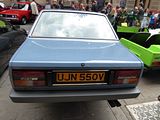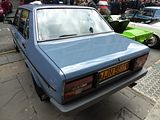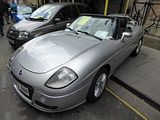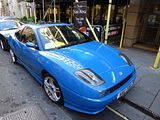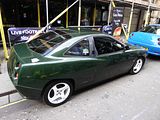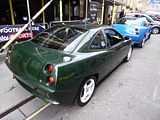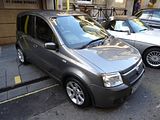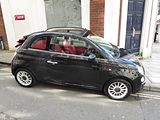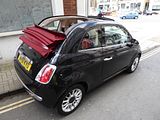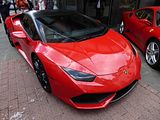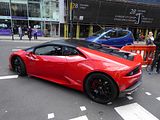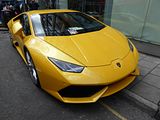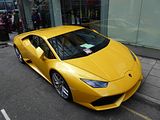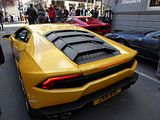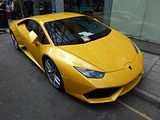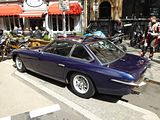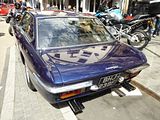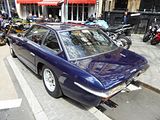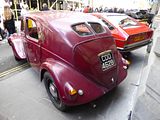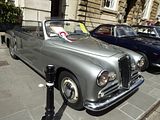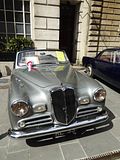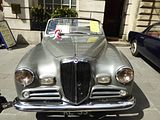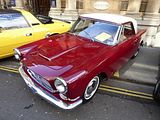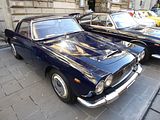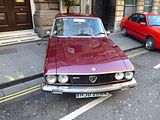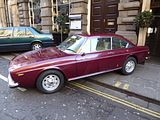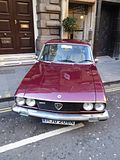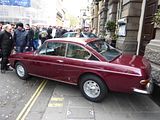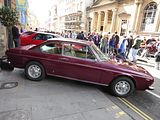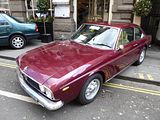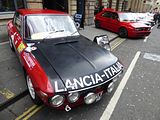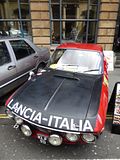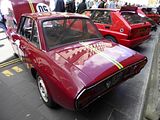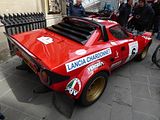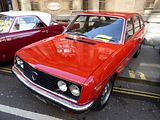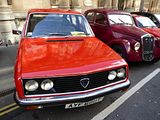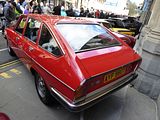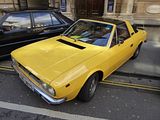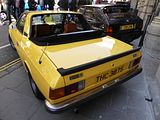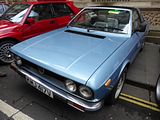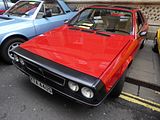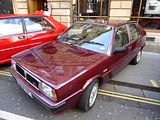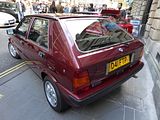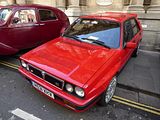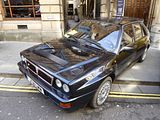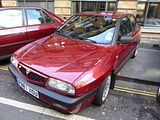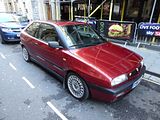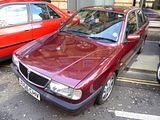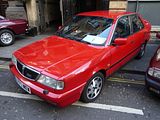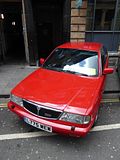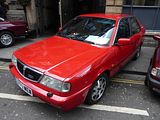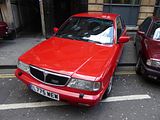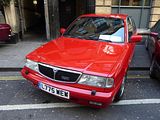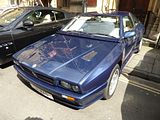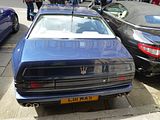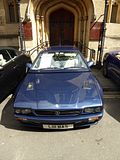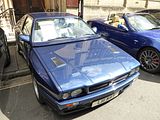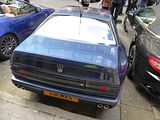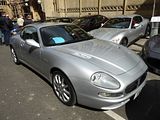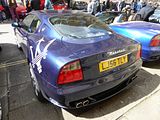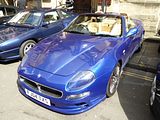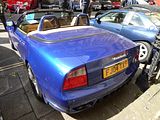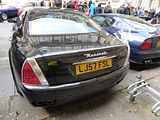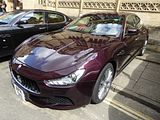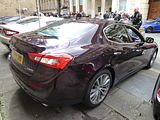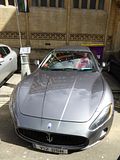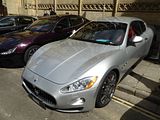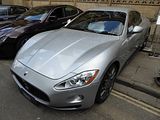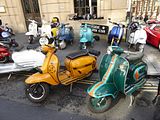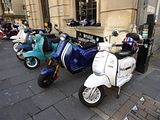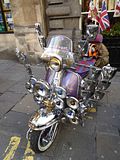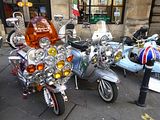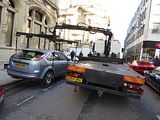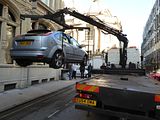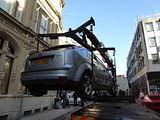April 2016 will prove to be a particularly good month for the Italian car enthusiast. As well as the monthly gathering at Ace Cafe, the Brooklands Auto Italia even sneaks in on the last day of the month, and for those who love Alfa Romeos (and there can be few lovers of Latin machines who don’t), there was Spring Alfa Day, which boasted a bumper turnout under sunny skies at Beaulieu, and then there is the event under review here, the Bristol Italian Auto Moto Festival, or BIAMF for short. The City Council may have cut back on their financial contribution in recent years, but thankfully, they’ve still co-operated with things that matter like getting streets closed off, so this popular event is still able to go ahead, with 2016 marking the 14th time that it has been held. In that time, the format has changed little. Owners of Italian cars and bikes are invited to register, until capacity is reached, and then begins the job of figuring how to fit the entry list onto 4 streets of the old commercial heart of Bristol, centred around Corn Street. Each year there is a featured marque for both the cars and the bikes, which is intended to encourage a greater number of applications than might be otherwise be received. For 2016, the chosen marque was Lancia, in honour of the 110th anniversary of the founding of the company by Vincenzo Lancia, and the selected bike marque was the Vespa, celebrating its 70th birthday. As the event drew close, registrations continued to arrive, with around 175 cars entered, and from what I can tell, almost all of them turned up on the day, thanks to some extent for sure, to the fact that despite a rather worrying looking forecast during the week, the event day turned out to be sunny, with only scattered clouds and a rather keen wind to remind us that it was still only Spring. The first cars arrived almost as soon as the marshalls were all on site, and they continued to turn up at a steady rate until the 10am “curfew”, so by the time I got the chance to see what was on the streets other than the one where I was posted, I found complete displays of cars. The crowds started to increase, too, and as in previous years, as the morning passed by, it did get exceedingly busy, so getting from one of the entry points to the central desk was a surprisingly long trip even though it was only a matter of a few hundred yards. Not only was there a good balance of cars from the different Italian marques, but there was a nice mix of cars which have been seen here a number of times before and those making their first appearance. With apologies to anyone whose car is not featured – and that is not many, I know – here is what attracted my camera:
ABARTH
After an increasingly strong showing of Abarths in previous years, numbers were way down this year. Down more than planned, as three more cars were booked. One was a simple no-show, a second non-appearance came as the owner, Salv Trapani underwent minor surgery a couple of weeks ago and was unable to drive (much to his chagrin, as he cites this as one of his favourite events of the year) and the third absentee I knew about as there was a rather plaintive post on the Abarth Owners Club forum on Thursday morning saying that the car had been involved in an accident and was badly damaged. That left 4 modern Abarths, all 500-based models, unsurprisingly, all different, and all making their first appearance here. In my case that was because I only swapped my original car for a new 595 Competizione last September. The other 595 here, belonging to Luther Jackson. was also an acquisition made in the last few months. Steven Homer has owned his bi-colore 500C for longer than that, but had not made the trip from Stratford before, and Paul Hatton – true to form, arriving unspeakably early, despite living at the eastern end of the M4 – brought along his much-loved 500 Essesse to complete the display.
The modern Abarths were joined by one “classic” one, a 595, based on the Nuova 500. Original versions of these are extremely rare, as not that many were built and not all of them survive, so this one, like most of the others you see, is in fact a recreation, but unless you knew, you probably would not guess. Needless to say, it attracted a lot of attention, not least because thanks to its diminutive size it could be parked right on the corner intersection of Corn Street and St Stephens Street, and it – deservedly – won the prize for “Best Abarth”.
ALFA ROMEO
One car which I think has been at every BIAMF that I have ever attended, and I am thankful that it has, is this one, Mike Hirst’s wonderful 1929 6C 1750 Super Sport Zagato. I make no secret of the fact that these 1930s Alfas are right at the top of my “Dream Garage” list. Actually, if I had one, it would probably sit in the living room, so I could stare at it all the time. The Zagato coachwork is just so elegant, and that Vittorio Jano-designed engine is a work of art that has few equals. Sadly, I am never going to be debating where I would put “my” 6C1750, as values of these cars have rocketed. Mike told me once that he had only paid a couple of hundred pounds for his car, but that was around 55 years ago, when the true value of cars like this was not understood. These days, you would be looking at a figure in excess of £1 million to get your hands on one, and they don’t come up for sale very often.
It is precisely because of the value of 1930s Alfas that David Roots, an inveterate attendee of this event and others in the area, resorted to building his own. His car, variously described as an Alfa Special or a “Bitsarrini” has made many appearances in Bristol, but it still pulls the crowds. He arrived, suitably dressed for the cold journey that he would have experienced in coming over from Frome in a car which has no real weather protection whatsoever, no doubt thankful that it was only the cold and not rain that were an issue associated with the early start. For those who are wondering quite what the make up of this car is, and who did not get the chance to read the information sheet that was displayed with the car, it was designed as an homage to the 1935 8C Tipo C 35 Monoposto. Just eight of these cars, with a larger 3.8-litre version of the famous Jano designed engine, sharing no castings with the earlier blocks, were individually built for racing in five months, as raced by Scuderia Ferrari. The 3.8 produced 330 bhp at 5500 rpm, and had 320 lb·ft from 900 to 5500 rpm., and 15.5-inch drum brakes all round. Though not a match for the big Mercedes and Auto Union on the faster circuits, they came into their own on the tighter circuits and races. The last time one came up for sale, in September 2013, it was the former Scuderia Ferrari 8C 35, in which Tazio Nuvolari had won the 1936 Coppa Ciano, and it sold for £5.9 million; a new world record price for any Alfa Romeo. Given the rarity of the car and the way prices have rocketed in recent years, ti is a fair guess that a genuine 8C like this would now have 8 digits in the price tag. Like many of us, David dreamed of owning a car like the original, but unlike most of us, he did the next best thing to paying the millions and decided to create his own. Back in 1989, somewhat deterred by the thought of the hours that could be spent lying underneath a rusty wreck at the side of the road, missing some obscure part that would need to be made specially. He decided to opt for a special combining retro styling with new bodywork and reasonably modern mechanics. A company called Classic Specials created that something, combining a bespoke chassis utilising MGB mechanics with a Lenham Healey bodyshell. Ten years later, in 1999, at the Castle Combe Classic Action Day he ‘blew’ the trusty B Series engine and that was the turning point which caused him to wonder if he could not actually design his own car. Many of us dream of doing this, but he actually decided to set about the task. Utilising the MG-Lenham chassis and Lenham Healey rear bodywork, the MG engine and gearbox were replaced with those from a 1969 Alfa Romeo 1750 GTV. Then a body had to be designed and constructed. This was done by making a buck from the aeroscreens forward, which was used to make a mould and moulding. Whilst it is not a precise rendering of the classic Tipo C, the result looks very professional, and the car always generates lots of positive and appreciative comments whenever it is displayed. Today was no exception.
As well as these two 1930s style Alfa, there were a vast array of more modern cars here. More Alfa Romeos than any other marque, which is not surprising, as that is quite normal at most Italian car events, though it did give the marshalls who were responsible for the Small Street area where they were to be parked, some apprehensions when they counted the number on the entry list and looked at the available space. However, they did all fit, and there was plenty of variety, with no more than two or three examples of any individual model type here. Not quite every model to come out of Arese in the last 50 years was here, with a few surprise omissions, such as no MiTo, 75 or 155, but this was still a great display of the history of this much loved marque.
Selected by the judges for a prize, and deservedly so was this fabulous grey coloured Giulia Spider. It was one of two of these pretty Farina styled cars present, with a red one being a later arrival. This body shape was first launched as part of the 101 Series back in 1955, but in 1962, the model was upgraded with the installation of a 1600cc twin cam engine, replacing the earlier 1290cc unit, at which point it was rechristened a Giulia. You can tell the later cars as they have a bulge in the bonnet, needed to clear the extra height of the larger engine. In this form it was produced for a further 4 years until the 105 Series Spider was ready.
Not surprisingly, there were several of the 105 Series Spider cars here. Although only sold in the UK for a short part of their near 30 year production run, a significant number of them have arrived on our shores and you can be sure that there will be several of them at an event like this, and so there were, with examples of the original “boat tailed” Series 1 cars joined by a Kamm-tailed Series 2 and one of the last Series 4 models.
Also from the 105 Series were the Coupe models, and slightly surprisingly, the only that my camera found, and indeed, from memory, the only one present was this late model 2000 GTV.
I was a little surprised when gazing at this stunning Montreal by just how many people said that they did not know what it was. Admittedly you don’t see them that often, even at Italian car events, as the model was expensive when new, and also gained a reputation for being one of those cars along with the Citroen SM and Triumph Stag that could cost a fortune to put right when (and everyone did think “when”, not “if”) it broke. Those days are largely gone, and if you want one of these V8 engined delights – described by Nick Grange as “sex on wheels” when he came up to it (!), then you won’t find one in decent condition for much less than £50,000 now.
Two years after the launch of the Alfetta saloon, Alfa followed up with a very pretty coupe. Styled by Guigiaro, this car, the GT, looked completely unlike the saloon on which it was based. The first cars had 1.8 litre four cylinder engines and then in 1976 the range was expanded both up and down with a 1.6 and a 2.0 model that adopted the legendary GTV name. In 1981, with the 2.5 litre V6 engine that had been developed for the ill-fated Alfa 6 luxury saloon available, Alfa was able to create a true rival for the 2.8 litre Capri with the GTV6. A facelift modernised the look of the car with plastic bumpers front and rear and a new interior looked rather better as well as being more ergonomically logical. These cars are more common than the earlier ones, and it was one of these, belonging to David Kell, which was here.
In 1976, Alfa pulled off the same trick with the Sprint version of the smaller AlfaSud. Once again, very pretty Giugiaro styling clothed familiar mechanicals but with the result looking completely from the standard Saloon model. The Sprint would continue to evolve with mechanical updates in line with the regular ‘Sud, but it went on to outlast its progenitor by some number of years, with the last cars produced in 1989. By that time, the facelift department had been in action several times, with increasing amounts of plastic being applied to the grille and bumpers, so this late model Veloce looks quite different in detail from the 1976 cars. It had rather more power at its disposal, too, with a 1721cc version of the flat four engine putting out 116bhp.
Replacement for the much loved AlfaSud range was the 33, which was launched in 1983. Just one example was on show here, the car belonging to Nick Grange, an inveterate attendee of almost as many events as me. Despite their rarity now, with cars only seen from time time, the Alfa 33 remains the best selling Alfa in history, with just under a million of them sold between 1983 and 1994. Precious few seem to have survived, as the car struggled to gain the affections of the enthusiasts in the way that the model’s predecessor, the AlfaSud, did. There were two distinct generations of the 33. The first ran from 1983 until 1990 and then a major facelift was applied with new front and rear styling to bring the looks more into line with the new 164. A mild facelift was applied to the first 905 series cars in late 1986. Exterior alterations were limited to clear indicator lens, wheel covers and alloy wheels of new design, the adoption of side skirts on all models, and a new front grille. Two-tone paint schemes were discontinued. There were more significant changes inside, with a more conventionally designed dashboard and steering wheel, which superseded the innovative moveable instrument binnacle. All 1.5 variants now had the 105 PS engine from the now discontinued 1.5 QV; a TI (Turismo Internazionale) trim level was exclusive to the front-wheel drive 1.5 hatchback. Changes were made to the suspension, brakes and gearbox, with closer-spaced ratios. A new 1,712 cc 116 bhp engine was introduced on the 1.7 Quadrifoglio Verde, which replaced the 1.5 QV. The 1.7 engine was developed from the 1.5 by enlarging bore and stroke; it also used new cylinder heads, incorporating hydraulic tappets. To cope with the increased power the new QV was equipped with vented front brake discs. The 1.7 QV looked close to its predecessor, but had lost the grey mid-body stripe and gained new alloy wheels, wind deflectors on the front windows, more pronounced side skirts and a rear body-colour spoiler on the boot lid. Inside it featured a leather-covered steering wheel, red carpets, and leatherette-backed sport seats upholstered in a grey/black/red chequered cloth. Diesel models were offered in some continental markets, but these were not sold in the UK, where only 1.5 and 1.7 Green Cloverleaf hatchback models were sold, as well as a market-specific 1.7 Sportwagon estate; all three were also available in “Veloce” versions, outfitted by Alfa Romeo GB with a colour-matching Zender body kit. Nick’s car is one of these.
Another car that is seen frequently at events, especially in the Bristol area is this fabulous 164 Q4 belonging to Daryl Staddon. The 164 was Alfa’s version of the “Type 4” project, which was a join venture with SAAB, Fiat and Lancia, resulting in the production of four very different looking contenders in the executive class, with a lot of shared componentry, including the doors. The Alfa was the last of the quartet to make its appearance, launching in the autumn of 1987, with a 3 litre V6 engine and a 5 speed gearbox. It quickly found favour as this was a Big Alfa which really hit the spot unlike its direct predecessor, the Six, which had remained a car of minority appeal. The potential market was widened when a 2 litre model was added to the range, with the characterful Twin Spark engine under the bonnet. It was one of these which I owned for 4 years and 160,000 miles, and which I regret ever letting go back to the leasing company. The Q4 was the very top of the range, added in late 1993. It had a 231 bhp 3 litre V6 engine coupled to a six speed Getrag transmission and four wheel drive, It was not sold in the UK, but a couple of examples have found their way here.
First thoughts about producing a replacement for the Alfetta GTV and the much older 105 Series Spider go back to the late 1980s. The task was handed to Pininfarina, and Enrico Fumia’s initial renderings were produced in September 1987, with the first clay models to complete 1:1 scale model made in July 1988. Fumia produced something rather special. Clearly an Italian design, with the Alfa Romeo grille with dual round headlights, recalling the Audi-based Pininfarina Quartz, another design produced by Enrico Fumia back in 1981, the proposal was for a car that was low-slung, wedge-shaped with a low nose and high kicked up tail. The back of the car is “cut-off” with a “Kamm tail” giving improved aerodynamics. The Spider would share these traits with the GTV except that the rear is rounded, and would feature a folding soft-top with five hoop frame, which would completely disappear from sight under a flush fitting cover. An electric folding mechanism would be fitted as an option. Details included a one-piece rear lamp/foglamp/indicator strip across the rear of the body, the minor instruments in the centre console angled towards the driver. The exterior design was finished in July 1988. After Vittorio Ghidella, Fiat’s CEO, accepted the design, Alfa Romeo Centro Stile under Walter de Silva was made responsible for the completion of the detail work and also for the design of the interiors, as Pininfarina’s proposal was not accepted. The Spider and GTV were to be based on the then-current Fiat Group platform, called Tipo Due, in this case a heavily modified version with an all new multilink rear suspension. The front suspension and drivetrain was based on the 1992 Alfa Romeo 155 saloon. Chief engineer at that time was Bruno Cena. Drag coefficient was 0.33 for the GTV and 0.38 for the Spider. Production began in late 1993 with four cars, all 3.0 V6 Spiders, assembled at the Alfa Romeo Arese Plant in Milan. In early 1994 the first GTV was produced, with 2.0 Twin Spark engine. The first premiere was then held at the Paris Motor Show in 1994. The GTV and Spider were officially launched at the Geneva Motor Show in March 1995 and sales began the same year. The cars were well received. At launch, many journalists commented that Alfa had improved overall build quality considerably and that it came very close to equalling its German rivals. I can vouch for that, as I owned an early GTV for eighteen months, and it was a well built and reliable car. In 1997 a new engine, a 24-valve 3.0 litre V6, was available for the GTV along with bigger, 12.0 inch brakes and red four-pot calipers from Brembo. The console knobs were changed from round central to rectangle ones and to a three-spoke steering wheel. Some versions were upgraded with different front bumper mesh to bring the wind noise down to 74 dBA. In May 1998 the cars were revamped for the first time, creating the Phase 2 models. Most of the alterations were inside. The interior was changed with new centre console, painted letters on skirt seals, changed controls and switches arrangement and different instrument cluster. Outside, the main changes included chrome frame around the grille and colour-coded side skirts and bumpers. A new engine was introduced, the 142 hp 1.8 Twin Spark, and others were changed: the 2.0 Twin Spark was updated with a modular intake manifold with different length intakes and a different plastic cover. Power output of the 2.0 TS was raised to 153 hp. Engines changed engine management units and have a nomenclature of CF2. The dashboard was available in two new colours in addition to the standard black: Red Style and Blue Style, and with it new colour-coded upholstery and carpets. The 3.0 24V got a six-speed manual gearbox as standard and the 2.0 V6 TB engine was now also available for the Spider. August 2000 saw the revamp of engines to comply with new emission regulations, Euro3. The new engines were slightly detuned, and have a new identification code: CF3. 3.0 V6 12V was discontinued for the Spider and replaced with 24V Euro3 version from the GTV. 2.0 V6 Turbo and 1.8 T.Spark were discontinued as they did not comply with Euro3 emissions. By the 2001-2002 model year, only 2 engines were left, the 2.0 Twin.Spark and 3.0 V6 24V, until the Phase 3 engine range arrived. The Arese plant, where the cars had been built, was closing and, in October 2000, the production of GTV/Spider was transferred to Pininfarina Plant in San Giorgio Canavese in Turin. In 2003 there was another and final revamp, creating the Phase 3, also designed in Pininfarina but not by Enrico Fumia. The main changes were focused on the front with new 147-style grille and different front bumpers with offset numberplate holder. Change to the interior was minimal with different centre console and upholstery pattern and colours available. Instrument illumination colour was changed from green to red. Main specification change is an ASR traction control, not available for 2.0 TS Base model. New engines were introduced: 163 hp 2.0 JTS with direct petrol injection and 237 hp 3.2 V6 24V allowing a 158 mph top speed. Production ceased in late 2004, though some cars were still available for purchase till 2006. A number of limited edition cars were produced during the model’s lifetime, of which the Cup, produced in 2001, is perhaps the best known. Based on the 3.0 V6 version, and inspired by a one-model Alfa GTV Cup race series, 419 of these cars were made. There were 180 3.0 V6 24V GTV Cups, out of which 155 RHD versions and 239 cars with 150 PS 2.0 TS were available in LHD only. 3.0 V6 cars were only produced in red ,while 2.0 TS cars were mostly silver with a few examples in red. Limited edition plaques, that were made of silver, differed for the RHD and LHD versions, having red and black texts accordingly. The differences between the standard car and the Cup version were a factory standard rear spoiler, front spoiler, side skirts, wheel arch side vents and titanium-like finish 17″ ‘telephone dial’ alloys, whilst mechanically the car was the same as the regular 215 hp V6. The interior was different in that had leather-material upholstery. There were a number of examples of the GTV and Spider here, showing the various changes outlined above, including one of the limited edition Cup models.
Alfa enjoyed something of a renaissance in the late 1990s and much of that can be attributed to the 156, a small sports saloon which not only won the “Car of the Year” award, but also generated plenty of magazine headlines asserting that it was a better car than the previously indomitable 3 Series BMW. I owned a 2.5 V6 model for 30 months, and almost had to have the keys forcibly removed from my pocket at the end of the lease. It was a beautiful car that drove well, and was just the right size, before cars underwent the bloat of recent years. The range started off with 1.8 and 2 litre 4 cylinder Twin Spark cars and the 192 bhp 2.5 V6 model, and then in the following years this grew with a 1.6 litre at the bottom of the range, a couple of diesels and the high end GTA which had a bored out 250 bhp 3.2 litre V6 to power it. The stylish Sport Wagon arrived in 2000, to rival the 3 series Touring. A number of 156s were here, including the very rapid GTA model.
It was hoped that the 166 would repeat the same success, but in the market segment above the 156, but sadly, it never did achieve the level of hoped for sales volume. The 166 had actually been designed before the smaller car, but quite rightly Alfa had fast-tracked the 156 knowing that the sector would generate far greater sales. There was nothing wrong with the way the car drove and interior quality was decent too, though not everyone was convinced by the front end styling with the very slim headlights. Alfa changed this with the mid-life facelift, and I think the Phase 2 cars do look better. The sole 166 here was a Phase 1 car, fitted with the 2.5 litre V6 engine, a version which many said was the “sweet spot” of the range.
The 159 was launched in 2005, going on sale a year later, and it took the place of both 156 and 166 in the range. Looking like an updated version of the last 156s, the car sat on a new platform that was a joint development with SAAB, though their version of the car – a 9.5 replacement – never made it to production. That meant that safety was a prime consideration, so the platform was strong, and also rather heavy. Ever tighter emissions standards meant the end of the revered Busso V6 engine and a new 3.2 litre unit co-developed with GM did not have the same sound track as its predecessor, so whilst the 159 was objectively a good car, it never quite found the same approbation as its predecessors. The planned GTA version was a victim of the 2007 Credit Crunch, and the car never really achieved its full potential which is a shame, as on looks alone, it should have been a winner, both in Saloon and Sport wagon guises. Several of them were here.
Sharing the same front end styling were the Brera and Spider models, which replaced the 916 series GTV and Spider cars. Because they shared the same rather strong and heavy platform, these cars were not quite as rapid as you might hope, but as stylish grand tourers, they excelled, even if quite a lot of them were delivered with a diesel engine. Prodrive turned their attention to the car to tighten up the handling, producing Brera models which gained an S badge on the rear pillars, and these are generally acknowledged to be the pick of the family.
It is quite amazing to realise that the Giulietta has been on sale for 6 years now. During that time, Alfa’s c-segment hatch has found many new fans and the fact that there will often be large numbers of these good looking models at events shows the affection in which they are held even when new. Surely a “classic” to join a long line of Alfa models that have acquired such status.
There can be even less doubt that the 4C models, seen here in the recently launched Spider guise, will achieve that status. The world’s press are still not unanimous in their opinions of this 2 seater sports car, finding plenty to fault, though most of the owners I have spoken to neither agree no care, loving these fabulous looking sports cars.
FERRARI
Twentyfive Ferraris were booked into the event, according to the list of attendees which the marshalls received at the start of the day, and it was my job to help get them all parked. Not only do most of them have not a lot of ground clearance, causing some challenges associated with the kerbs over which they would have to drive, in St Stephen’s Street, but as they started to arrive, I did wonder if there would actually be space for them all as Ferraris are quite big! Luckily, there was. Just. But had one more been booked, then there would have been a problem so tight is the space allocation at this event. Unlike previous years, where some early models have been part of the display, there were was nothing earlier than the 80s this time, but even so this assembly of models was clearly a crowd puller, as the street on which they were parked was heavingly busy all day long.
328 GTS
Mondial
F355 Berlinetta and Targa
Most numerous model on the day, which is not really a surprise, given the number of these cars which were sold here when new, were the 360 Modena and later F430 cars, with several Coupe and even more Spider examples of both on show.
458 Italia
400i
Selecting a “best” Ferrari from this collection was an almost impossible task, but in the end, the judges opted for this 512 TR entered by John Tribe, and I would find it hard to disagree. When this car was new, it was thought of as big, and especially wide. Looking at it now, it really does not appear to be so at all, showing just how cars have grown in the 3 decades since it was designed.
456 GT
FIAT
Oldest Fiat present was this splendid 520 Torpedo model of 1928, and indeed that date made it the senior citizen of the event. Fiat had used the 520 name for a V12 model earlier in the decade, and then decided to reuse it for their upper middle-class” model produced from 1927. During the early decades of the 20th century, once steering wheels had replaced centrally positioned steering tillers, European automakers tended to place the driver and his steering wheel on the right side of the car regardless of local regulations or conventions concerning which side of the road cars should be driven. By the 1920s, as the number of motorised vehicles on the roads increased, clearer consensus had become necessary in the more populous parts of Italy about the need for everyone to drive along the right side of the road. The 1927 Fiat 520 was one of the first cars, presumably in recognition of this trend, to place the steering wheel on the left side of the car. The 520 was offered with a variety of different body styles, and came with a straight 6 2244cc engine developing 46 hp. It was replaced by the Fiat 521 in 1928, although the 520 appears to have continued in production until 1929, by when more than 20,000 six-cylinder examples had been produced.
Just nine years its junior was this 500 “Topolino” from 1937. Known for being the car which really put Italy on wheels, the Topolino was one of the smallest cars in the world at the time of its production. Launched in 1937, three versions were produced until 1955, all with only minor mechanical and cosmetic changes. It was equipped with a 569 cc four-cylinder, side-valve, water-cooled engine mounted in front of the front axle, which meant that it was a full-scale car rather than a cyclecar. The radiator was located behind the engine which made possible a lowered aerodynamic nose profile at a time when competitors had a flat, nearly vertical grille. The shape of the car’s front allowed exceptional forward visibility. The rear suspension initially used quarter-elliptic rear springs, but buyers frequently squeezed four or five people into the nominally two-seater car, and in later models the chassis was extended at the rear to allow for more robust semi-elliptic springs. With horsepower of about 13 bhp, its top speed was about 53 mph and it could achieve about 48 mpg. The target price given when the car was planned was 5,000 lire. In the event the price at launch was 9,750 lire, though the decade was one of falling prices in several part of Europe and later in the 1930s the Topolino was sold for about 8,900 lire. Despite being more expensive than first envisioned, the car was competitively priced and nearly 520,000 were sold. Nowadays the car seen here is known as the 500A, and this shares its body with the later 500 Model B, but the later car had more power, a heady 16 hp. It was made between 1948 and 1949. The Model A was offered as a 2-door coupé, 2-door cabriolet and a 2-door van, while the Model B also introduced a 3-door estate under the name 500 B Giardinetta (“estate car”). The Model C was introduced in 1949 with a restyled body and the same engine as Model B, and was offered in 2-door coupé, 2-door cabriolet, 3-door estate and 2-door van versions. In 1952, the Giardinetta was renamed the Belvedere (“A turret or other raised structure offering a pleasant view of the surrounding area”, referring to its sunroof). The Model C was produced until 1955 and there was one of these on show as well, though maddeningly, I don’t seem to have taken its photo.
Replacing the original 500 was the Nuova 500, launched in 1957 and there were three examples of them here, all of them 500F models. This much loved little car went on to sell by the million, with a large number having survived especially in Italy where the car was particularly popular. A series of updates were made to the car during its 20 year production life, with the changes which made the 500F, the follow onto the 500D, being most easily spotted by the front hinged doors. The 500F was launched in 1965 and continued in production alongside the late 500L, until 1973.
I spotted this car on the attendee list and confess that I had no idea what it might be. And then when it drove in through “my” entrance”, I have to admit to being none the wiser, though the large “Impala” lettering on the front did at least confirm its identity, and the noise it emitted made it clear that there was a 2 cylinder engine mounted out the back. Some research after the event elicited that the Impala Burro, to give the car its full name, is based on a kit produced by a Devon-based company called Foulkes Development Ltd, who between 1981 and 1985 made glassfibre bodies that could be combined with the mechanicals from a Fiat 500 or 126. A slightly revised version was made available in 1984, with modified front wings and reshaped wheel arches. The kit cost £626 at launch. It is believed that around 30 were made. Intriguingly, all the information I found on the Impala online was in German. Probably because this was something no-one much had seen before, this little car attracted lots of attention throughout the day, which I hope made the owner, Max Nailor, think it worth his very chilly drive to the event.
Parked next to it was a sublime 1600 Cabrio belonging to Mike Lamplough. He showed the car at the event last year, where it drew notable comment and adulation, so it was great to see it again, especially as it is believed to be the only example in the UK. , Similar in outline to the 1500 Cabriolet models on which it is based as well as the earlier 1200TV, a few of which are in the UK, the 1600 sports an OSCA engined twin cam of 1,568 cc, which develops 90 PS. It was available at the same time as the 1500 Cabriolet, which was from 1961 to 1966, and can easily be distinguished from the 1500 model by its additional lamps at the outer corners of the grille. Mike has owned this car since late 2014. The car was first sold to a buyer in Italy, but then was moved to the US where it lived until 1996, at which point it returned to Italy. When he bought it, and got to see what he had actually paid out money for, he was delighted to find that this was a very solid car indeed, needing very little work done to it, though it has been treated to new leather seats, replacing the original vinyl items. To my eyes, the simple Pininfarina styled lines of this car are just about perfect from every angle.
A very different sort of Fiat, but also quite an eye-catcher was this 900T Pandora. There were quite a few of these, and other derivatives of the 850T and 900T bodyshell on our roads throughout the 1970s and 1980s, but like almost everything else of that era, suddenly they all disappeared and there are very few of them left now, and certainly not as nice as this one. The model is part of the 850 family that first appeared in 1964, with this overall shape first offered as the 850 Familiare, a boxier and slightly larger heir to the Fiat 600 Multipla. It featured space for seven passengers in three rows, which made it suitable for groups including children and thin adults. It was too small to accommodate in comfort seven large adults. In Van guise, it was known as the 850T. The 850 Familiare and related 850T continued in production till 1976 long after the saloon version of the 850 had been replaced by the Fiat 127. In 1976 the Fiat 900T was introduced, retaining most of the body panels of the 850 Familiare, but featuring the 903 cc engine from the Fiat 127 (although, in this application, still mounted behind the rear axle). The 900T benefitted from significant enhancements in 1980, at which point it was renamed the 900E. A number of them were sold as camper vans, and in the UK, these were badged as the FIAT Amigo, and the 7 seater model was called the Pandora. Production finally ended in 1985.
Also rear-engined were a pair of 600-based models which had been upgraded with Abarth engines, taking them some of the way to the legendary Abarth 850TC and 1000TC cars.
The X1/9 was first launched in 1972, but it took 5 years before Fiat decided to import it into the UK. A facelift in 1979, with larger bumpers and a raised engine cover to house the bigger 1500cc engine did perhaps not make it look better, but this characterful mid-engined sports car had massive appeal when new, and set the stage for the Toyota MR2 which finally presented itself as a rival 12 years after the Bertone/Fiat model appeared. Later cars came in a variety of special editions and lost the Fiat badging in favour of Bertone ones. This was the only example of the model on show this time.
Fiat’s family car of the mid to late 1970s was the 131 Mirafiori. Once a common sight on our roads, there are very few left, so it was good to see a couple of them here. The later of the pair, a Series 3 car, in 1400CL guise is an event regular, though looking at it, I suspect that it is going to need some cosmetic surgery before too long, as the dreaded rusting appears to be bubbling through many of the panels. Joining it was a Series 2 Supermirafiori. This had a 1585cc twin cam engine which gave the car a lively performance compared to Cortina and Marina models of the day. The model seen here is a recent import, acquired by its owner as a reminder of the car which his father enjoyed when he was growing up.
The Cinquecento Sporting was an inspired decision by Fiat to create a fun, but affordable car based on the diminutive 1993 Cinquecento, Boasting a larger 1100cc engine and more power – up from 45 bhp to 58bhp, and styling details that made it clear that you had more power under your right foot, this little pocket rocket was like a roller skate on wheels, and deservedly popular, as it was still cheap enough to buy and insure and run that even young drivers could afford it.
Last fully open topped Fiat until the recent launch of the new 124 Spider was the Barchetta. Fiat’s 1990s answer to the MX5 and the MGF, These cars are, in my opinion, better looking than either of those two rivals, and yet they are almost criminally ignored in this country. Only ever sold in left hand drive, which doubtless put some people off, this is a fun car, based on the Punto platform and mechanicals, so if anything is needed, it is actually quite cheap to fix.
There were three examples of the Fiat Coupe here. Styled by Chris Bangle, many will tell you that this his best design, and although it was quite a courageous look that he created, there are far more fans than detractors of the car. Only produced for a few years, with UK sales taking what seemed like an age to start, following a European launch in late 1993, the Coupe is one of those cars which achieved “classic” status almost as soon as production ended. Thanks to galvanised bodies, the cars have not suffered from the rust problems that were still afflicting models produced in the 1990s and once it was worked out how to change the cambelt on the 5 cylinder engines without having to take the engine out, the costs of running one of these surprisingly spacious and practical cars have made them a popular and affordable machine.
Fun for a lot less money, when new, came with the Panda 100HP, a sporting version of Fiat’s diminutive city car, which it is widely rumoured was going to bear Abarth badges until a last minute declaration (unbroken for now, but rumours suggest it may well be rescinded) that Abarth models do not have 4 or 5 doors.
There were a couple of examples of the current Fiat 500. A black 500C was, I assume, a late arrival and was parked round down the end of Small Street. Parked more centrally, with the other Fiat model was a 500C Gucci edition. Designed to appeal to the most style conscious car buyer, the Gucci came in two styles named after their metallic body colour, called Gucci Black and Gucci White. Standard equipment included a green and red strip on the roof embossed with the Gucci logo, two tone Frau leather upholstery, metallic paint, a height adjustable steering wheel, electric front windows, 12V socket, chrome body trim and unique 16-inch alloy wheels. In addition, all Gucci models came with stop/start, Bluetooth and a leather steering wheel with audio controls. Only petrol models were available in top-spec Gucci trim, both the cheaper 1.2 and the newer 0.9-litre TwinAir. None of this came cheap, though.
LAMBORGHINI
Just three Lamborghinis were present this year. Two of them were the latest model, the Huracan, and these cars pulled the crowds like no other. The red one, parked right at the end of St Stephens Street, made an early exit, and attracted lots of interest from the crowd who had been gathered round the car, but that was nothing compared to the throng that accompanied the yellow car when its time to exit came. there must be GigaBytes of footage of this from the moderately sized army of people of all ages who ran after it with phones, cameras, camcorders and selfie sticks much in evidence.
It was the third Lamborghini which the judges awarded a prize and which is actually far rarer than the modern ones, but I guess that its understated looks meant that quite a lot of attendees would not know what it was, or that it had the same 4 litre V12 engine under the bonnet was you would find in the Miura and Espada. This is an Islero, a four seater which was produced in the late 1960s, and was effectively the successor to the 350/400GT models which marked the start of Ferruccio Lamborghini’s venture into car production. Featuring a V12 engine (of course), this 2+2 GT car was only produced for 2 years, during which time 225 units were made.
LANCIA
With the exception of the legendary Delta Integrale, the memory of which, and enthusiasm for, shows little sign of abating even though it is well over 20 years since the last new one was made, Lancia is a marque that is known and appreciated by a small, and probably diminishing group of people. With the brand not selling cars in the UK for over 20 years, when the latest models were offered here, they came with Chrysler badges, as the Fiat empire thought that these would have more brand recognition than the proper Lancia branding that should have featured. Only a handful of the quirky Delta and diminutive Ypsilon were sold here before the proverbial plug was pulled last year, and none of these cars were represented at this event, but, pleasingly, there was a long line of models from happier times in the marque’s history.
This 1947 Aprilia is quite a regular at the show. Very much a car that is used, as opposed to one that has been heavily restored and only making occasional sorties, this is still a car well worth looking at. The Aprilia was launched in 1937, and was one of the first cars to be designed using a wind tunnel. This was in collaboration with Battista Farina and Politecnico di Torino and allowed the car to achieve a record low drag coefficient of 0.47. This was the last of Vincenzo Lancia’s designs, with the car entering production in the very month in which he died. The first series (model. 238) of which 10,354 units were built between 1937–39 featured a 1,352 cc V4 motor providing 47 bhp. The second series (model. 438) of which 9,728 were made, was first seen in 1939 and production of which continued after the war, had its engine capacity increased to 1,486 cc which provided 48 bhp. A Lusso model of this second series was also offered as well as a lungo (lengthened) version. 706 of these were made between 1946 and 1949, making a grand total of 20,082 cars, with 7,554 additional chassis for coach built bodies, produced in Turin along with about 700 in France. With the Aprilia, Lancia followed their tradition of offering cars with the steering wheel on the right even in markets seen by other manufacturers as left hand drive markets. Outside the UK and Sweden customers increasingly picked the optional left hand drive versions, however.
The Aurelia was Lancia’s large car offering in the 1950s. The B20 GT Coupe and B24 Spider models are the best known and most often seen, along with occasional sightings of the B10 Berlina, but there was also an open topped model like this, the B50 Cabriolet. This splendid machine, belonging to Chris Sherman, and the actual 1951 Geneva Show car, has been seen at this event before. Not surprisingly, it was awarded the prize for best Lancia of the day. It truly is magnificent.
Another car which makes plenty of appearances in the area is this little Appia Coupe. The Appia was a small car that was made between 1953 and 1963, in three distinct Series. First series Appias were only offered in factory body styles, but this changed with the second and third series Appias, which were also built as a platform chassis intended for coachbuilt bodies. Towards the end of 1955 a first batch of 14 chassis based on the brand new second series Appia were built and handed over to some of the most prominent coachbuilders of the time: Allemano, Boano, Ghia Aigle, Motto, Pininfarina, Vignale and Zagato. Initially all fourteen chassis were coded Tipo 812.00, based on standard saloon mechanicals; five of were upgraded to a more powerful 53 PS engine and floor-mounted gearchange, and given the new type designation 812.01. At the April 1956 Turin Motor Show, a month after the successful introduction of the second series Appia in Geneva, five specially bodied Appias were shown: a coupé and a two-door saloon by Vignale, a coupé each from Pininfarina, Boano and Zagato. Between Spring 1956 and Spring 1957 the coachbuilders presented their one-off interpretations of the Appia at various motor shows. Later more 812.01 chassis were built, bringing the total of unique to thirteen. Of the coachbuilders who had worked on the first fourteen chassis, two were selected by Lancia to produce special Appia body styles: Pininfarina for the coupé, and Vignale for the convertible. Their nearly definitive proposals debuted at the March 1957 Geneva Motor Show, and soon went into limited series production. Built by their respective designers on chassis supplied by Lancia, these were included in Lancia’s own catalogue and regularly sold through Lancia dealerships. In the later years other variants were added to the official portfolio: Vignale’s Lusso, Zagato’s GTE and Sport, and Viotti’s Giardinetta. All of these variants were built on the 812.01 type chassis with the more powerful engine and floor change; when the third series saloon debuted its mechanical upgrades were transferred to the chassis, and the engine gained one horsepower 54 PS. In early 1960 a revised, more powerful engine was adopted, putting out 60 HP thanks to a new Weber carburettor and an inlet manifold with a duct per each cylinder. In total 5,161 Appia chassis for coachbuilders were made. The model seen here, a Pininfarina styled Coupe started its life in South Africa.
The Flaminia was launched in 1958, as a replacement for the Aurelia. The first model was the Berlina, a large 4 door saloon which took much of its styling inspiration from the Florida concept car that had been shown a couple of years earlier. As was common at the time, a number of the Italian styling houses also had the chance to present Coupe and Convertible versions of the car, and during the lifetime of the model, three did so: Pininfarina, Zagato and Touring. The Pininfarina cars came first, and then several years later, Zagato and Touring produced their versions., It was one of the last of these, and in my opinion, the most elegant of the three, which was to be seen here. These cars were very expensive when new, so it is perhaps not a surprise that only 37 of them were made in right hand drive form. This car started its life overseas.
Perhaps the least known Lancia of the day was this, which was also the first car to arrive that did not belong to a marshall, a fabulous Flavia 2000 HF Coupe, belonging to Terry Wood. I was immediately excited, as you see these cars so rarely, and they are just so elegant. The 2000 HF Coupe was the final evolution of a design which started out as the Flavia Coupe, which was introduced in 1971, at the same time as the equally rare 2000 Berlina, to replace the Series II Flavia Coupé. It had the same basic bodyshell as the Flavia, designed and made by Pininfarina, but with a number of updates, which included a new grille in matte black instead of chrome, with headlamps incorporated into the now wider intake, new bumpers (with rubber strips on the HF), and the tail was shorn of its vestigial tailfins, with a raised and squared boot lid. The interior did not undergo significant change, merely detailed refinements of the previous design. The engine was adopted from the 2000 sedan and available in two states of tune: carburettors on the 2000 Coupé, Bosch electronic fuel injection and engine management on the 2000 HF which raised its output to 123 bhp, the same as contemporary BMW and Alfa Romeo models. This improvement, however, was never publicised by Lancia because the marketing department believed that their targeted customers would less favourably respond to a campaign that emphasised power and performance rather than quality, technical sophistication and riding comfort. The HF was recognisable by the body-side rubbing-strip, wooden Nardi steering wheel, and Cromodora magnesium alloy wheels. Both versions had a 5-speed manual transmission with a dog-leg gearbox arrangement, and they both had power steering, still quite a novelty at the time. They were very well appointed with polished stainless steel brightwork, as opposed to chromed mild steel. The 2000 and 2000HF Coupé are considered to be some of the last true Lancia cars, designed before Fiat took control of the company in 1969. The cars do not suffer the corrosion problems associated with later generation Lancias and are generally regarded as being more resistant than contemporary rivals from other manufacturers. The cars were expensive when new and hence only sold in small numbers in the UK, and they are particularly rare now, so seeing one of these elegant machines was a real treat. This car has only recently been put back on the road, having been found in Ireland and then undergone a meticulous restoration to put it into the splendid condition in which it was seen here.
Lancia replaced the long-running Appia with a new model in 1963, the Fulvia. Like the larger Flavia which had been shown 3 years earlier, it came with front wheel drive, and a host of exquisite engineering which ensure that even though it was expensive, it was actually not profitable for its maker, and was a direct contribution to the marque’s bankruptcy and take over by Fiat in 1969. It was not long before the initial Berlina saloon model was joined by a Coupe. First seen in 1965. the Coupe proved to be the longest lived of all Fulvia variants, surviving until 1976 when it was effectively replaced by the 1300cc version of the Beta Coupe. Before that, it had undergone a steady program of updates, with more powerful engines, including a capacity increase from the initial 1200cc of the narrow angle V4 to 1300 and then later 1600cc, and the car was developed into a successful rally machine for the late 60s. The Sport Zagato version was designed by Ercole Spada at Zagato and was intended to be the more sporting model of the range. It was also considerably more expensive. Early cars had an unusual side hinged bonnet, but this was changed on the Series 2 models which were launched in 1970, and which also switched to all-steel bodies.
Given a prime position at the top of Corn Street, this Stratos replica was one of the cars that generated the most interest. It may be nearly 40 years since Lancia retired the car from its rally car duties, but this model, the first purpose-designed rally car remains immensely popular, and a car that people of all ages seem to have no trouble in identifying. Original Stratos models are incredibly rare, so most of the time when you see one, it is in fact a replica, but many of these are extremely well-produced, with the only obvious clue that you are not looking at an original being the fact that it has right hand drive.
Strange as it may seem to a generation accustomed to seeing our roads full of BMW, Mercedes and Audi models, in the mid 1970s, when you could afford better than the company Cortina or Marina, chances are that you would have considered a Lancia Beta. This elegant saloon was very popular, until, that is, it was exposed on the consumer affairs tv program “That’s Life” that Lancia had been buying back and scrapping cars with premature rust in them. Sales dived immediately, even though almost all cars of the period were just as rot prone. That means that survivors are particularly rare. This Series 2 1300 model made an appearance at the event last year and it was nice to see it again this time.
As well as the Berlina, Lancia filled out their range with first a Coupe, then a three door model called HPE and finally an open topped model, the Spyder, two examples of which were to be seen here. Launched in 1976, the open-topped version of the Coupe was designed by Pininfarina but actually built by Zagato, which is why it was known as the Zagato in America. The Spyder used the Coupé’s shorter wheelbase and featured a targa top roof panel, a roll-over bar and folding rear roof.. Early models did not have a cross-member supporting the roof between the tops of the A to B pillars. Later models had fixed cross-members. It was initially powered by either the 1600 or 1800 twin-cam engine, later being replaced by the new 1.6 and 2.0. It never received the IE or VX engines. There were fuel injected engines for the US market. Lancia spelt the name with a “y” rather than an “i” possibly to differentiate the car from the Alfa Romeo Spider, though most people tend to use the “Spider” spelling these days. 9390 examples were built.
Considered to be part of the Beta family, though there is an awful lot about the car that is very different from the front wheel drive Berlina, Coupe, HPE and Spyder, was the MonteCarlo, one example of which was displayed. First conceived in 1969, with a a final design completed by 1971 by Paolo Martin at Pininfarina, what was initially known as the Fiat X1/8 Project, was originally designed as Pininfarina’s contender to replace Fiat’s 124 Coupe, but it lost out to Bertone’s cheaper design, which became the Fiat X1/9. Rather than scrap the proposal completely, it was developed further, when Fiat commissioned Pininfarina to build a 3.0 litre V6 mid-engined sports car. An X1/8 chassis was used as the start point, and developed for the first time in-house by Pininfarina and not based on any existing production car. Due to the 1973 Oil Crisis, the project was renamed X1/20 and updated to house a 2.0 litre engine. The first car to be made out of the X1/20 Project was the Abarth SE 030 in 1974. The project was passed to Lancia, and the road car was launched at the 1975 Geneva Motor Show as the Lancia Beta MonteCcarlo. It was the first car to be made completely in-house by Pininfarina. Lancia launched the MonteCarlo as a premium alternative to the X1/9, with the 2 litre twin cam engine rather than the X1/9’s single cam 1300. Both used a similar, based on the Fiat 128, MacPherson strut front suspension and disc brakes at both front and rear. Lancia Beta parts were limited to those from the existing Fiat/Lancia standard parts bin, the transverse mount version of the Fiat 124’s twin cam engine and the five speed gearbox and transaxle. MonteCarlos were available as fixed head “Coupés” and also as “Spiders” with solid A and B pillars, but a large flat folding canvas roof between them. Sales were slow to get started, and it soon became apparent that there were a number of problems with a reputation for premature locking of the front brakes causing particular alarm. Lancia suspended production in 1979 whilst seeking a solution, which meant that the car was not produced for nearly two years. The second generation model, known simply as MonteCarlo now, was first seen in late 1980. The braking issue was addressed by removing the servo, as well as few other careful mechanical tweaks. The revised cars also had glass panels in the rear buttresses, improving rear visibility somewhat, and there was a revised grille. In the cabin there was a new three spoke Momo steering wheel in place of the old two spoke one, as well as revamped trim and fabrics. The engine was revised, with a higher compression ratio, Marelli electronic ignition and new carburettors which produced more torque. It was not enough for sales to take off, and the model ceased production in 1982, although it took quite a while after that to shift all the stock. Just under 2000 of the Phase 2 cars were made, with 7798 MonteCarlos made in total.
Lancia launched the Delta in 1979, as what we would now think of as a “premium hatch”. Offered in 1300 and 1500cc engines, this car, which collected the prestigious “Car of the year” award a few months later, brought Italian style and an expensive feeling interior to a new and lower price point in the market than Lancia had occupied since the early days of the Fulvia some 15 years earlier. The range grew first when a model was offered using the 4 speed AP automatic transmission and then in late 1982, more powerful models started to appear, with first a 1600cc engine, and then one with fuel injection, before the introduction of the HF Turbo. All these cars kept the same appearance and were quite hard to tell apart. These were the volume models of the range, but now they are very definitely the rare ones, so it was nice to see Geoff Tipping’s 1600GT here.
These days it is the 4WD models, most of which were badged Delta Integrale which are the best known and the ones you see surprisingly often, considering how few were sold when they were new, thanks to a combination of the fact that they were quite costly and that they only ever came with left hand drive. The Integrale evolved over several years, starting off as the HF Turbo 4WD that was launched in April 1986, to homologate a new rally car for Lancia who needed something to fill the void left by the cancellation of Group B from the end of 1986. The Delta HF 4X4 had a four-wheel drive system with an in-built torque-splitting action. Three differentials were used. Drive to the front wheels was linked through a free-floating differential; drive to the rear wheels was transmitted via a 56/44 front/rear torque-splitting Ferguson viscous-coupling-controlled epicyclic central differential. At the rear wheels wa a Torsen (torque sensing) rear differential. It divided the torque between the wheels according to the available grip, with a maximum lockup of 70%. The basic suspension layout of the Delta 4WD remained the same as in the rest of the two-wheel drive Delta range: MacPherson strut–type independent suspension with dual-rate dampers and helicoidal springs, with the struts and springs set slightly off-centre. The suspension mounting provided more isolation by incorporating flexible rubber links. Progressive rebound bumpers were adopted, while the damper rates, front and rear toe-in and the relative angle between springs and dampers were all altered. The steering was power-assisted rack and pinion. The car looked little different from the front wheel drive models. In September 1987, Lancia showed a more sophisticated version of the car, the Lancia Delta HF Integrale 8V. This version incorporated some of the features of the Delta HF 4WD into a road car. The engine was an 8-valve 2 litre fuel injected 4-cylinder, with balancing shafts. The HF version featured new valves, valve seats and water pump, larger water and oil radiators, more powerful cooling fan and bigger air cleaner. A larger capacity Garrett T3 turbocharger with improved air flow and bigger inter-cooler, revised settings for the electronic injection/ignition control unit and a knock sensor, boosting power output to 185 bhp at 5300 rpm and maximum torque of 224 lb/ft at 3500 rpm. The HF Integrale had permanent 4-wheel drive, a front transversely mounted engine and five-speed gearbox. An epicyclic centre differential normally split the torque 56 per cent to the front axle, 44 per cent to the rear. A Ferguson viscous coupling balanced the torque split between front and rear axles depending on road conditions and tyre grip. The Torsen rear differential further divided the torque delivered to each rear wheel according to grip available. A shorter final drive ratio (3.111 instead of 2.944 on the HF 4WD) matched the larger 6.5×15 wheels to give 24 mph/1000 rpm in fifth gear. Braking and suspension were uprated to 284 mm ventilated front discs, a larger brake master cylinder and servo, as well as revised front springs, dampers, and front struts. Next update was to change the engine from 8 valves to 16. The 16v Integrale was introduced at the 1989 Geneva Motorshow, and made a winning debut on the 1989 San Remo Rally. It featured a raised centre of the bonnet to accommodate the new 16 valve engine, as well as wider wheels and tyres and new identity badges front and rear. The torque split was changed to 47% front and 53% rear. The turbocharged 2-litre Lancia 16v engine now produced 200 bhp at 5500 rpm, for a maximum speed of 137 mph and 0–100 km/h in 5.5 seconds. Changes included larger injectors, a more responsive Garrett T3 turbocharger, a more efficient intercooler, and the ability to run on unleaded fuel without modification. The first Evoluzione cars were built at the end of 1991 and through 1992. These were to be the final homologation cars for the Lancia Rally Team; the Catalytic Evoluzione II was never rallied by the factory. The Evoluzione I had a wider track front and rear than earlier Deltas. The bodyside arches were extended and became more rounded. The wings were now made in a single pressing. The front strut top mounts were also raised, which necessitated a front strut brace. The new Integrale retained the four wheel drive layout. The engine was modified to produce 210 bhp at 5750 rpm. External changes included: new grilles in the front bumper to improve the air intake for engine compartment cooling; a redesigned bonnet with new lateral air slats to further assist underbonnet ventilation; an adjustable roof spoiler above the tailgate; new five-bolt wheels with the same design of the rally cars; and a new single exhaust pipe. Interior trim was now grey Alcantara on the Recaro seats, as fitted to the earlier 16V cars; leather and air conditioning were offered as options, as well as a leather-covered Momo steering wheel. Presented in June 1993, the second Evolution version of the Delta HF Integrale featured an updated version of the 2-litre 16-valve turbo engine to produce more power, as well as a three-way catalyst and Lambda probe. A Marelli integrated engine control system with an 8 MHz clock frequency which incorporates: timed sequential multipoint injection; self-adapting injection times; automatic idling control; engine protection strategies depending on the temperature of intaken air; Mapped ignition with two double outlet coils; Three-way catalyst and pre-catalyst with lambda probe (oxygen sensor) on the turbine outlet link; anti-evaporation system with air line for canister flushing optimised for the turbo engine; new Garrett turbocharger: water-cooled with boost-drive management i.e. boost controlled by feedback from the central control unit on the basis of revs/throttle angle; Knock control by engine block sensor and new signal handling software for spark park advance, fuel quantity injected, and turbocharging. The engine now developed 215 PS as against 210 PS on the earlier uncatalysed version and marginally more torque. The 1993 Integrale received a cosmetic and functional facelift that included. new 16″ light alloy rims with 205/45 ZR 16 tyres; body colour roof moulding to underline the connection between the roof and the Solar control windows; aluminium fuel cap and air-intake grilles on the front mudguards; red-painted cylinder head; new leather-covered three-spoke MOMO steering wheel; standard Recaro seats upholstered in beige Alcantara with diagonal stitching. In its latter years the Delta HF gave birth to a number of limited and numbered editions, differing mainly in colour, trim and equipment; some were put on general sale, while others were reserved to specific markets, clubs or selected customers. There were examples of most of these different versions of the car here, with HF Integrale, several Evo 1 and an Evo 2 car on display.
By the time that Lancia launched the second generation in 1993, the marque’s sales in the UK had fallen to negligible, so the decision was taken not to offer this model and indeed to pull out of the British market altogether. A handful of Delta 2 models have found their way to these shores over the years, among them Simon Davis’ HPE HF car.
The Lancia Dedra, produced from 1989 to 2000 was designed to support, and later to replace, the Prisma and is generally considered to be the saloon version of the second generation Delta, that took a further four years before being released. The Dedra was sold in the UK, and it had a tough job on its hands, as it entered a particularly competitive part of the market, that for medium-sized executive saloons. The design, by Ercole Spada of the I.DE.A Institute, produced an excellent drag coefficient of only 0.29. Lancia positioned the Dedra as offering prestige, exclusivity, personality and comfort, achieved through a high level of equipment and use of materials (e.g. Alcantara) as well as details such as special paints, alloy wheels and an attention to soundproofing, ventilation and other issues. Inside the ability to obtain the perfect driving position was helped by the adjustable seats, steering wheel and electrically adjustable mirrors. Safety, both passive with a structure designed to minimize injury in an accident, and active, such as ABS and airbag, was also near the top of the Dedra’s agenda. It was based on the Fiat Tipo-floorpan, because the idea of Fiat Group at the end of the 80s was to achieve, from a single floorpan (for reasons of economies of scale), four different cars from the same base: good value for money for the Fiat Tipo (1988), elegance for Lancia Dedra 1989, convenience at a competitive price for the Fiat Tempra (1990) (with its large boot) and sportsmanship for the Alfa Romeo 155 (1992). Also were designed on the same floorpan the Lancia Delta and the Fiat Coupe. When the Dedra was launched, it was a good time for Lancia: The Thema had been facelifted a year earlier, and despite being on the market for five years was selling well, the Delta (1979), thanks its continued success in competition was living a second youth, and the Y10 had a slight restyling and good sales. However, the Dedra was not a strong success outside Italy. A major facelift in 1993 did little to boost the car’s sales success and the whole Lancia range including the Dedra was withdrawn from RHD markets a year later. The car, after 1993 also sold as a station wagon, remained popular on the Italian market until it was replaced by the all-new Lybra at the end of the 90s. In 1991 the Dedra Integrale had been added to the range. It used the same engine and transmission as the Delta Integrale 8v, a 2-litre 4-cylinder fuel injected twin cam engine, fitted with contra-rotating balancing shafts, and a Garrett T3 turbocharger and associated inter-cooler to aid volumetric efficiency that boosted power output to 171 PS. The Dedra Integrale also used the same permanent 4-wheel drive of the Delta Integrale, and included a new Visco Drive 2000 traction control system and it also included the electronically controlled suspension available as option in the 2.0 and upper versions. A total of 418,084 Dedras were manufactured. There are only a handful in the UK, so it was quite a surprise to see 2 of them here: Paul Talbot’s 2 litre Turbo model was joined by Chris Hopkins’ Integrale model.
There was no sign of the enigmatic Gamma this year, but there were a couple of the model that replaced it, the Thema. This was Lancia’s luxury car based on the Tipo Quattro platform, one of four cars to do, the others being the Alfa Romeo 164, Fiat Croma and Saab 9000. The Thema re-established Lancia as a high-quality luxury manufacturer with a galvanised steel chassis and rust protection that equalled or bettered that of its competitors. Build quality was higher than the Fiat Croma’s and on par with the Saab 9000, with which it shared a great deal of body engineering, including its doors. Lancia’s sales organisation, however, was poor in many markets and secondhand values for the car suffered. The first series was built between 1984 and 1988, and was available with 1995 cc 8 valve, twin-cam fuel injected or turbocharged engines or a 2849 cc V6. For most European markets a 2445 cc four-cylinder turbodiesel was also available, though this was not offered to UK buyers. One of these cars, in 2 litre Turbo ie spec, which was the most popular among UK buyers, was on show here. For a while, the Thema changed little, but in 1986, a station wagon designed by Pininfarina was added to the range, though this was also never sold in the UK. 21,074 Thema station wagons were built. The second series Thema, also seen here, and also with a 2 litre Turbo engine, was presented in the Paris Motor Show in September 1988 with 16v 2.0 litre engines replacing the 2.0 litre 8v units increasing the power output of the injection version to 146 PS and the turbo to 205 PS. The diesel engine size increased marginally, to 2499 cc. The series two was then replaced by the facelifted third and last series, introduced at the Paris Motor Show in September 1992 and produced from 1992-1994. Production of the Thema ceased in 1994 when Lancia presented a replacement. the Kappa, a car that would not be sold in the UK.
Final Lancia model on show was an Ypsilon. The first small car to bear Lancia badges was the Y10, introduced in 1985, though that was only true for UK markets, as the continental European cars were badged Autobianchi, a brand which had never been sold in the UK. When that model was superceded by another small, stylish hatch, the Y, it took Lancia badges everywhere it was sold. There have been three generations of this model, which had its name spelled out in full, as Ypsilon when the second generation car arrived in 2003.
MASERATI
Oldest Maserati at the event was a real rarity, a Shamal. In keeping with Maserati tradition, the Shamal is named after a wind, in this case a hot summer wind that blows in large areas of Mesopotamia. My favourite of the Biturbo generation Maserati models, it was introduced on 14 December 1989 in Modena, when Maserati president and owner Alejandro de Tomaso showed it to the press, it was the last model announced under the De Tomaso ownership, as in January 1990 half of Maserati was acquired by Fiat S.p.A.. Sales began in 1990. The Shamal was designed by Marcello Gandini, of Bertone fame. Clearly based on the Biturbo, as you can see in the doors, interior, and basic bodyshell, all of which were carried over from the Biturbo. Gandini’s styling signature is visible in the slanted profile of the rear wheel wheel arch, also present on the fourth generation Quattroporte IV and first seen on the Lamborghini Countach. Nonetheless, the Shamal has a look all of its own, with the centre pillar wrapping around the cabin as a roll bar, always finished in black, a distinguishing characteristic of the Shamal. The name “Shamal” appears on either side of the central pillar in chrome lettering. The car has alloy wheels, a small rear spoiler and a blacked-out grille with chrome accents. Another defining feature of the Shamal are its numerous headlamps in individual housings: outer round Carello low beams of the then-new projector type, inner rectangular high beams, combined indicators and position lamps in the bumper, and two pairs of square lights in the lower grille—fog lamps and driving lamps. The two-seat interior of the Shamal features extended leather seat cushions, temperature control and the famous Maserati oval clock, which is situated in the centre of the dashboard. The gear lever is finished in elm. While built for comfort as well as performance, the Shamal was not as luxuriously appointed as the similar Maserati Ghibli II. The Shamal used a traditional front-engine, rear-wheel-drive layout and an all-steel unibody construction. Suspension was by MacPherson struts upfront and semi-trailing arms at the rear. All Shamals were equipped with an adaptive suspension developed by Maserati together with Koni. The system varied the damping rates, based on road conditions and the level of comfort desired. It was powered by an AM 479 3,217 cc square (bore and stroke 80 mm or 3.1 in) V8 engine, with two overhead camshafts per bank, and four valves per cylinder. It was twin-turbocharged with two IHI turbines and intercoolers, and equipped with a Marelli IAW integrated electronic ignition and fuel injection ECU per cylinder bank. The engine put out 325 PS at 6,000 rpm and 430 N·m (320 lb·ft) at 3,000 rpm. Power was sent to the rear wheels through a six-speed Getrag manual transmission and Maserati’s Ranger limited-slip differential. The manufacturer claimed a top speed of 170 mph and a 0 to 62 mph acceleration time of 5.3 seconds. The final year of production for the Maserati Shamal was 1996 and factory figures indicate that 369 examples were produced. Only a handful are in the UK and this is the only one in blue.
Maserati replaced their entire range with a new model in July 1998. Known internally as the Tipo 338, and christened the Maserati 3200 GT, this very elegant 2+2 grand tourer was styled by Italdesign, whose founder and head Giorgetto Giugiaro had previously designed, among others, the Ghibli, Bora and Merak. The interior design was commissioned to Enrico Fumia. Its name honoured the Maserati 3500 GT, the Trident’s first series production grand tourer. Sold mainly in Europe, the 3200 GT was powered by the twin-turbo, 32-valve, dual overhead cam 3.2-litre V8 engine featured in the Quattroporte Evoluzione, set up to develop 370 PS (365 hp). The car was praised for its styling, with the distinctive array of tail-lights, consisting of LEDs, arranged in the shape of boomerang being particularly worthy of comment. The outer layer of the ‘boomerang’ provided the brake light, with the inner layer providing the directional indicator. The car was also reviewed quite well by the press when they got to drive it in early 1999, though it was clear that they expected more power and excitement. That came after 4,795 cars had been produced, in 2001, with the launch of the 4200 models. Officially called the Coupé and joined by an open-topped Spyder (Tipo M138 in Maserati speak), these models had larger 4.2 litre engines and had been engineered so the cars could be sold in America, marking the return to that market for Maserati after an 11 year gap. There were some detailed styling changes, most notable of which were the replacement of the boomerang rear lights with conventional rectangular units. Few felt that this was an improvement. The cars proved popular, though, selling strongly up until 2007 when they were replaced by the next generation of Maserati. Minor changes were made to the model during its six year production, but more significant was the launch at the 2004 Geneva Show of the GranSport which sported aerodynamic body cladding, a chrome mesh grille, carbon fibre interior trim, and special 19-inch wheels. It used the Skyhook active suspension, with a 0.4 inch lower ride height, and the Cambiocorsa transmission recalibrated for quicker shifts. The exhaust was specially tuned to “growl” on start-up and full throttle. The GranSport was powered by the same 4244 cc, 90° V8 petrol engine used on the Coupé and Spyder, but developing 400 PS (395 hp) at 7000 rpm due primarily to a different exhaust system and improvements on the intake manifolds and valve seats. A six-speed paddle shift transmission came as standard. The GranSport has a claimed top speed of 180 mph (290 km/h) and a 0–62 mph (0–100 km/h) time of 4.8 seconds. There were examples of the 3200GT, the 4200GT, the Spyder and the GranSport here.
There was also one example of the Spyder here Based on the 3200GT model which had been launched in 1999, the Spyder – only ever available with the larger 4224cc engine – was first unveiled to the public at the 2001 Frankfurt Auto Show. It presaged changes which were coming to the Coupé model which saw it evolve from the 3200GT to the 4200GT, the Coupe being launched some four months later at the 2002 Detroit Auto Show. Both cars were then produced until 2007 when the new GranTurismo model replaced them. The release of the Spyder heralded Maserati’s return to the North American market after an 11-year hiatus. Almost as soon as it was introduced, the Spyder was selected by Forbes as the Best GT for 2001. Both cars were designed by Giorgetto Giugiaro of ItalDesign, and their striking looks, as well as the fact that the cars were good to drive ensured that the famous brand whose very existence had seemed somewhat imperilled in the early 1990s became re-established as a force to be reckoned with. The cars were built at the Viale Ciro Menotti plant in Modena.
Other Maserati models on show included the last generation Quattroporte, and several of the current range with a Ghibli in the stunning colour of Rosso Folgore joined by a dark blue one brought along by Dick Lovett Swindon and a number of the GranTurismo and GranCabrio cars.
ON 2 WHEELS
2 wheeled Italian machinery is very much part of the event as well. These range from a number of motorbikes from well known brands such as Ducati and Moto Guzzi as well as less familiar ones such as Laverda, as well as rows of far less powerful machines such as the Vespas and Lambretta models. Although I am no expert on these, they always make a colourful sight and are a popular addition of the event.
AND FINALLY…..
Events like this do not just happen by a number of enthusiasts turning up on the day. They are extremely important, of course, as without them, there would be no cars and bikes to see, and it is always a worry that despite what people have said and indeed paid for, that especially if the British weather turns against us all, then they will stay away. That did not happen this year. But far more important is all the ground work that is done in the weeks and months leading up to an event. I know this from the work I do for the Abarth Owners Club, but there’s actually a lot more that is involved for something like this, where streets have to be closed off – legally – medical services are required and a team are required to help run things on the day. With all the meticulous planning that Paul Hanmore, who conceived the event, and has run it for so long, and now David Morris, the organiser for 2016, undertake, most things go exactly to plan. But not quite everything. There are always a few stray vehicles parked up on the streets of this event, either in ignorance or defiance of the street closures, which cause the marshall team some anxiety when they arrive at 7am. Sometimes the problem resolves itself as cars disappear early enough, but not always and that is when what looks like fairly drastic action is required. There was one case in 2015 and sure enough, in 2016, it was necessary again to invoke the powers that had been granted and to remove one offending vehicle and relocate it on a nearby street. As this was left as late as possible, in the hope the owner would return, there was quite a crowd gathered to watch what is a very slick operation indeed.
There was one medical incident during the day, which the on-site team were well able to handle, but apart from that, the 2016 BIAMF will be remembered for yet another spectacular showing of the best of Italian cars and bikes. It attracted big crowds, and lots of enthusiasm from everyone I spoke to, with plenty of people asking for the 2017 date so that they could put it in the diary. The answer to that question will have to wait for a few months yet, but I can declare now that once it is announced, this event will be inked into my 2017 Events program, and I will also not hesitate to offer my assistance to marshall at the event.

